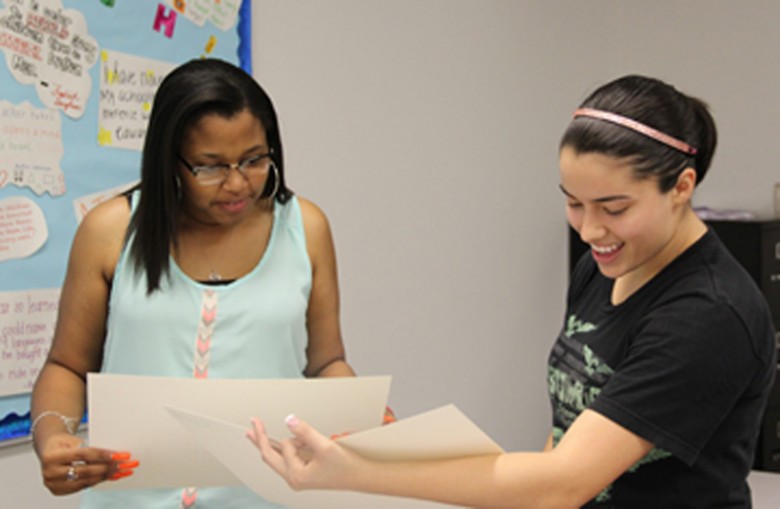COM Child Development Program launches flipped classes

Two students rap while another adds the backbeat: “This is how we do it … teacher accountability and parent involvement.”
For the first time this fall, students in College of the Mainland professor Susan
Napoli’s child development class are learning the way they hope their students will
learn – hands-on.
During today’s class, students sketch their ideal classrooms, create diagrams contrasting
effective and ineffective teachers and sing their lesson takeaways to tunes such as
“Let It Go” from Disney’s “Frozen.”
The goal, said Napoli, is twofold: to help students retain information and to show
them interactive ways to teach their own students. The hybrid face-to-face and online
class is modeled after the “flipped learning” style, which lets students do quizzes
and textbook work outside of the classroom and reserves time in the classroom for
discussion and collaboration.
Today, after students depict their dream classroom, Napoli encourages them to each
share their plan briefly with two or three others. It’s like show and tell, she adds,
but faster and easier for children with short attention spans.
“Can I steal that idea?” asks one student.
It’s just one of the options Napoli gives to fill her students’ teaching toolboxes.
“I don’t lecture anymore,” said Napoli. “Active learning means we do things like look
at case studies, we have discussions, we analyze articles. We do problem solving and
role-plays. Sometimes I’ll have them review by doing a skit.”
Students admit it’s a challenge—in addition to in-class work, they take quizzes, read
materials and post in discussion boards online.
“You do a lot more thinking,” said student Shay Earwin. “You know the expression,
‘Give a man a fish and he’ll eat for a day; teach a man to fish and he’ll eat for
a lifetime’? She’s empowering us to learn for ourselves.”
A COM professor since 1999 with a master’s degree in education, Napoli collected active-learning
strategies for years but “got the final pieces to the puzzle” during a COM workshop
with Dr. Mark Taylor, a former college professor. She launched the “flipped” or hands-on,
face-to-face and online course this fall and is already succeeding in improved class
attendance and on-time assignment submissions.
“I’m getting a different perspective on how to teach,” said student Ashley Hill, of
Friendswood. “We’re in small groups. I can learn from (others’) experience and (they)
can learn from my experience.”
Megan Searcy, of Dickinson, hopes to incorporate what she’s learned in an elementary
classroom.
“We have more fun here,” Searcy said. “We get to do activities and get a more hands-on
experience.
“Each kid has a different learning style, so we learn the way they do. Everything
we learn in here, we can take to our own classrooms.”
For more information about the COM Child Development/Education Program, visit www.com.edu/childdevelopment
or call 409-933-8391.
